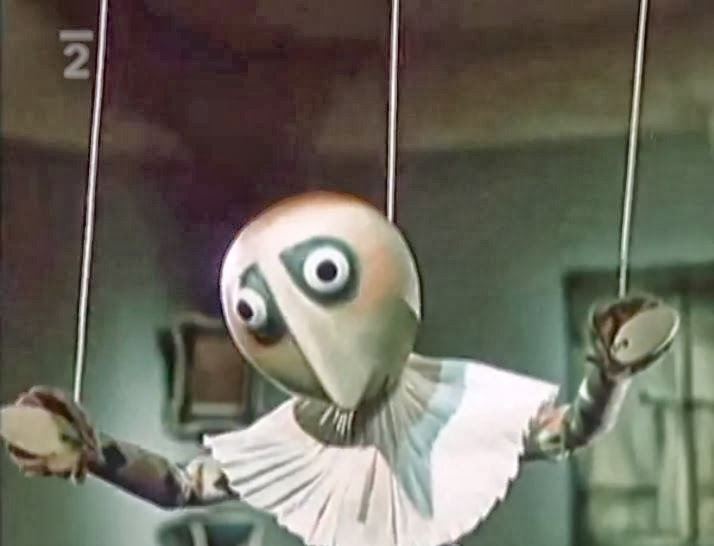Vukotic creates this animation through the use of traditional animation (cel animation), which works well with the cartoony stylised illustrations used with in the video. The animation contains simple geometric and triangular shapes, in which the main character of the video uses to create other characters or objects whilst at the beach, for example, the car, shark and BBQ.
I felt that the main purpose of this video was to entertain the main older audience. I feel that a younger audience would not be suitable for this video, as the plot of the animation doesn't include any repetition in which the audience could better understand the objective.
The entertainment of the video can be seen through the comedy values of the piece, such as the shark turning against the main character, which was an attempt to get the woman to fall for him but backfires.
 |
| Still from video 1 |
The main character enjoys a day at the beach, catching a fish for his lunch, however he gets lonely and creates a woman. He tries to get the woman to fall for him, by making a dangerous situation in which he could save her from, in this case he created a shark and had it swim after her in the sea. He saves her but to his disappointment, she spots a muscly man and runs for him.
- End -
The plot of the animation was very interesting through how the main character made objects, including his car, BBQ, towels and even other characters through the use of air into balloons, which formed triangular or geometric shapes beforehand. I loved the ending, in which a nail 'pops' the main character and we find out that he too is a balloon and he deflates, which left me with questions. If he was the creator of the balloon woman, then who was the creator of him?
 |
| Still from video 2 |
The illustrative style of the animation, with the block colours and line variation, reminded me of the work from Hanna Barbera. For example the animations of Yogi Bear and Pink Panther. I felt that the line and even the movement of the characters in Vukotic just reminded me of the Barbera animations, the humour and also the exaggerated movements that entwine with the characters personality. The main difference between the animations of Hanna Barbera and Vukotic's is that of the main target audience, Barbera being for a young audience and Vukotic's being a slightly older audience.
 |
| Yogi bear cereal advert - 1960s |
 |
| Pink Panther |
In about the same time as this video, The Hand by Jin Trnk, in which a puppet is forced against his will by a Hand, which I believe symbolised the dominance and superiority of the Nazis in WW2, the puppet sculptor caged and made to create this sculpture for the Hand. The Puppet manages to escape and unfortunately dies an ironic death as the thing he cherishes the most ends up being the end of him, his beloved flower pot.
The animation style of both of the videos differed, through the modelling and stop motion of 'the hand' and the traditional cel animation of Surogat. I felt that both of the animations styles used worked well with the plot of the videos, for example with "The Hand", the modelling and stop motion seems to make the audience grow attached to the puppet, whereas the "Surogat" uses cel animation which connects to the audience immediately with thoughts of entertainment and comedy, just through the line and colour used.
The background context of both animations blend into each other, through the aftermath of WW2, the cold war, and the great depression. I felt that the Surogat animation wanted to be entertaining to lift peoples spirits up from the devastation of the great depression, which left families homeless, the lack of jobs and the heightened mass amount of the unemployed. The animation was much like an aid for an escape from reality.
Watch "Ersatz (Surogat)" on video above
Watch another example of Dusan Vukotic's work, Osvetnik on the video above




2.jpg)

